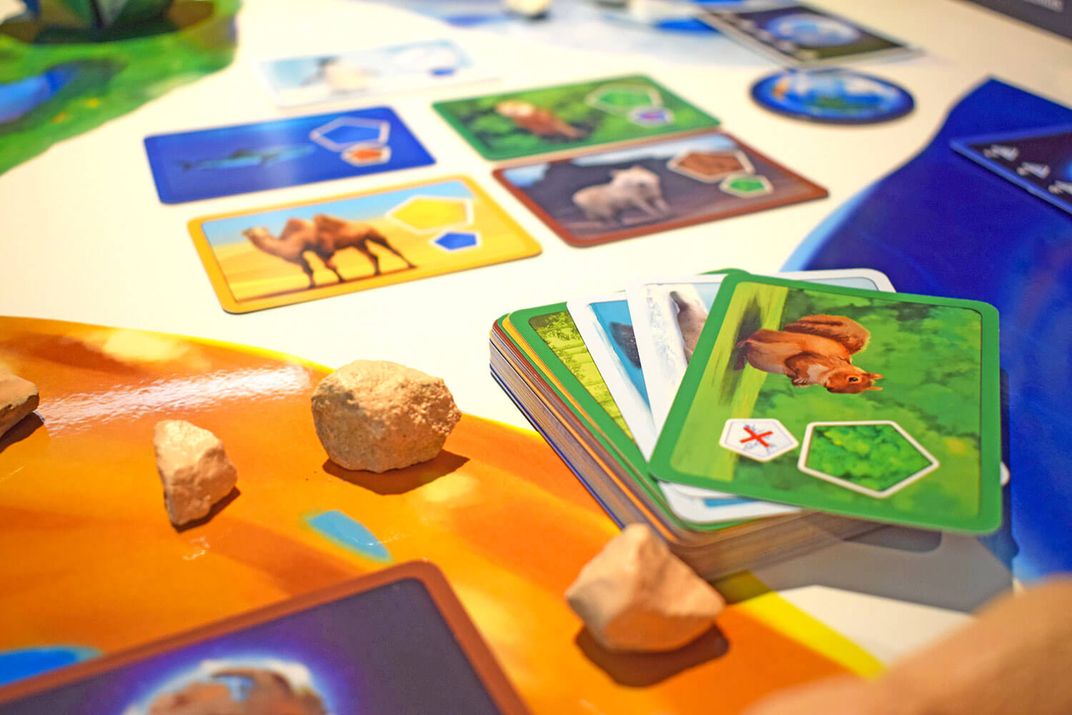This Board Game Asks Players to Craft a Perfect Planet
In ‘Planet’, players compete to create worlds capable of sustaining the highest possible level of biodiversity
/https://tf-cmsv2-smithsonianmag-media.s3.amazonaws.com/filer/b8/76/b8763b4b-1a56-49fb-a298-4c8176c770ec/planet-components-2.jpg)
A new board game released to coincide with Earth Day places the world's fate in players’ hands, enabling them to build and populate biomes in a race to produce the perfect planet.
Fittingly titled “Planet,” the award-winning game tasks two to four players with transforming blank planet “cores” into oases replete with forests, oceans, glaciers, mountain ranges, deserts and other natural habitats. Across 12 turns, competitors must balance these varying environments, each of which supports certain animal species, to create a planet capable of supporting the highest possible level of biodiversity.
Urtis Šulinskas, the designer behind “Planet,” tells Earther’s Yessenia Funes that the game spotlights the “beauty and diversity of the … species that are living on planet Earth,” as well as “the importance of creating and preserving natural environments.” In lieu of a new United Nations report detailing how human influence has left up to one million species vulnerable to extinction, this message feels more prescient than ever.
To start, each player receives a 12-sided planet core and a “Natural Habitat” objective card stating an overall goal for the game. According to the official instructions, this card might encourage you to create a certain number of areas, or small triangles that make up larger continents, in order to receive a set number of points—two points for 11, 12 or 13 glacier areas, for example—at the end of gameplay.
Next, participants start adding continents, represented by magnetic tiles consisting of five triangular sub-areas, to their planet. The five triangles found on each continent tile represent different kinds of environments. Adjacent triangles, or areas, of the same color constitute distinct regions. A continent could include a forested region made up of three connected areas, for instance, in addition to an isolated water area and one desert triangle.

Beginning in round three, players can also obtain animal cards, signaling the emergence of life on the game’s various planets. Each animal has its own set of habitat requirements: As Funes points out, penguins require icy continents touching water, while blue whales need planets with five separate ocean regions. Reindeers thrive in expansive glacier regions, but these glacier tiles cannot touch any desert areas.
“Planet” concludes after round 12, at which point all cores should be covered by 12 continent tiles and all animal cards should be awarded. The player with the most points—based on completion of objective cards and number of animal cards—wins the game, which lasts between 30 to 45 minutes overall.
“Choosing the right terrain combinations and placing them wisely while observing other players is the key to victory,” Sulinskas says to Earther’s Funes. “However, in the end, there is a pleasant feeling for each player holding their own unique planet, that they have designed.”
Unlike “Wingspan,” an avian-themed board game that took the gaming world by storm earlier this year, “Planet” lacks decisive scientific rigor. According to Funes, the 45 animal cards fail to identify each species’ name, and the habitation parameters they set out don’t always align with real-world trends. In the game, meerkats require mainly desert regions, and tigers must live near forests—sensible enough, but increasingly implausible when you add in the requirement that the meerkat’s deserts must touch ice, and the tiger’s forests must touch deserts.
Those actually playing “Planet” will likely find themselves more concerned with strategy (Geek Dad’s Jonathan H. Liu notes that those choosing continent tiles based on an objective card and those choosing based on which tiles will support the most animals can both post winning scores) than scientific accuracy. Regardless of whether one opts to play for fun or to learn, the game’s underlying message is apparent. Animals can only thrive in certain environments, and the more humans interfere with Earth’s ecosystems, the further our actual planet moves from the vision of sustainability exemplified by the game's fictional ones.
/https://tf-cmsv2-smithsonianmag-media.s3.amazonaws.com/accounts/headshot/mellon.png)
/https://tf-cmsv2-smithsonianmag-media.s3.amazonaws.com/accounts/headshot/mellon.png)